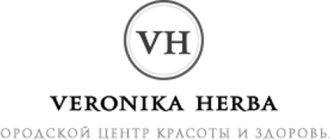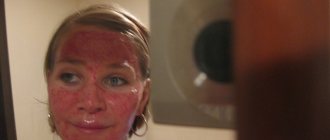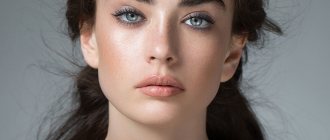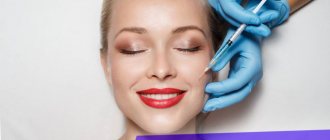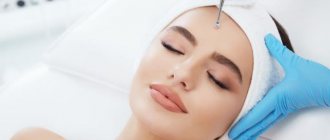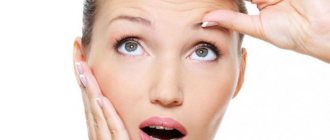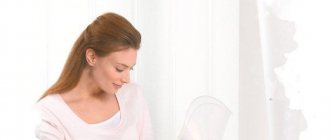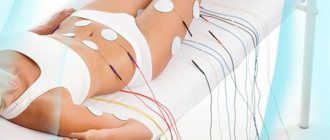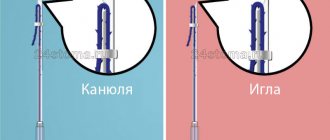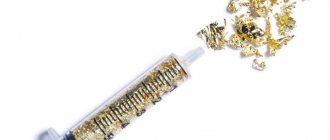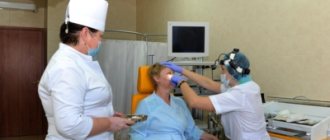I am often asked what the laser facial resurfacing procedure is.
Let's look at how the procedure works and what effect you can expect.
Before laser facial resurfacing, a series of photographs are taken. In direct projection.
45 degrees left.
In lateral view on the left.
45 degrees to the right.
In lateral projection on the right.
Before the procedure, age-related changes around the eyes are assessed.
The number and depth of wrinkles is determined.
Excess skin of the upper and lower eyelids is also assessed.
The depth of wrinkles and pores on the cheeks is assessed.
Before the procedure, the facial skin is treated with antiseptics.
An anesthetic cream is applied to cleansed facial skin, which reduces or completely eliminates pain during laser resurfacing.
Anesthetic cream is applied to the skin an hour before the procedure.
Before the procedure, the anesthetic cream is removed from the skin with an antiseptic. The facial skin is numbed and the patient is ready for the procedure.
Laser resurfacing is performed using a modern erbium laser FOTONA. The only laser that allows you to combine the effectiveness of traditional lasers with a short recovery period and minimal risk of complications. The Fotona laser is not just an erbium fractional laser, but an entire workstation equipped with several modes that allow the entire range of fractional, classical ablative (resurfacing) and surgical procedures to be performed at a high level. Before the procedure, all necessary modes are configured. The modes are selected individually for each patient, taking into account the characteristics of the skin.
The first pass is performed with a laser beam, which removes the surface layer of skin - the epidermis.
Layer-by-layer evaporation occurs on the surface of the skin at which the laser beam is directed.
The forehead skin has been treated. Removal of the surface layer of skin.
Laser resurfacing of the eyelid area will reduce deep wrinkles and completely remove fine wrinkles. The skin of the eyelids also shrinks, which reduces the “bags” under the eyes.
Laser chin resurfacing reduces the pores on the skin and makes it more elastic and firm.
To achieve the desired result, you need to use the laser beam several times over the same place on the skin, usually 3-4 times.
A whitish coloration of the skin after exposure to laser pulses usually indicates that the intraepidermal level of the skin has been reached during treatment with an erbium laser.
After each pass, an anesthetic gel is additionally applied to the skin, which allows you to minimize the discomfort that may appear during laser resurfacing.
Laser resurfacing of the right cheek. During the procedure, cells evaporate and a white coating remains on the skin.
The procedure is performed in comfortable conditions. If necessary, during the procedure you can connect equipment that will monitor the work of the heart.
Laser resurfacing is performed by treating the entire surface of the skin until damaged areas of the skin are removed or until blood spots appear, indicating that the papillary dermis has been reached. At the level of the papillary dermis, the maximum therapeutic effect is achieved with minimal risk of side effects.
Facial skin is treated with erbium laser.
To achieve maximum results, after laser resurfacing, fractional resurfacing of all areas of the skin is performed using a fractional attachment. Additional treatment of pores, scars and deep wrinkles of the facial skin occurs. The laser beam creates microscopic cylindrical depressions in the skin. Their depth and diameter are determined by the energy of the laser beam, controlled by the doctor during the procedure.
Fractional resurfacing can reduce skin pores and acne scars.
Fractional nose resurfacing allows you to reduce pores.
Fractional chin resurfacing reduces deep pores.
Fractional resurfacing of the upper lip will reduce deep wrinkles.
As a result of laser fractional skin rejuvenation, micro-depressions in the treated area heal, the skin around them tightens, new collagen fibers are formed, and due to this, the skin looks much younger.
The patient's face after the procedure.
After laser resurfacing, Bepanthen ointment is applied to the face.
After the procedure, a recovery period is required, as a new layer of skin needs to form.
2-3 days after the procedure, thin crusts form, which come off within 5-7 days. After the crusts come off, the skin becomes reddish in color. During this entire time, you need to apply special moisturizers. Skin redness and swelling can be observed for 2-3 weeks, in some cases up to 4-6 weeks. In case of severe pain, it is necessary to take painkillers.
Sterile wipes are applied.
After the procedure you will be able to go home.
After the procedure, you should avoid direct exposure to sunlight and use sunscreen cosmetics with a high level of ultraviolet protection (at least 30) for 3 months after resurfacing.
What types of scars are there?
- Hypotrophic scars. They are located below the skin level and form unsightly pits. Mostly they remain after acne and chicken pox. To remove acne scars, you usually need more than one procedure.
- Normotrophic scars are located at the skin level, their surface differs from the skin in its uneven surface and color. They can be removed in one go.
- Hypertrophic scars. These are scars that often form after a deep cut. They protrude above the general level of the skin. It can be removed with laser polishing several times.
- Keloid scars. Outwardly they look like hypertrophic ones. Typically, such a scar is wider than its base. It may hurt, and the person experiences unpleasant itching. They appear in people whose bodies are prone to forming such scars even after minor cuts.
How to choose the right procedure
Laser rejuvenation in combination with peelings and sculptural firming massage is prescribed for people with deformational type of skin aging. They have noticeable bags under their eyes, sagging facial skin, folds on the neck, and drooping eyelids.
For the muscular type of skin aging, laser rejuvenation is indicated in combination with mesotherapy, chemical peels and ultrasound therapy. This type of aging is characterized by good development of facial wrinkles, but insufficient development of subcutaneous fat tissue. A number of anti-aging procedures help eliminate drooping eyelids, pigmentation, pronounced nasolabial folds and drooping corners of the lips.
Those with a combination skin type are recommended to choose chemical peels in combination with laser rejuvenation, biorevitalization and mesotherapy to eliminate external defects. Such patients often want to get rid of the abundance of fine wrinkles in the forehead and eyes, as well as sagging soft tissues in the middle and lower part of the face.
How is laser scar removal surgery performed?
The essence of laser scar removal is that scar tissue is removed layer by layer. Using an erbium laser, the epidermis is evaporated. At the same time, the depth of impact is strictly controlled. As a result, blood circulation improves at the scar site, lymphatic drainage improves and the formation of healthy skin is stimulated.
Depending on the amount of scar tissue, the doctor decides what type of anesthesia to use: local or general. In normal cases, local anesthesia is used.
If the scar is small, the person does not feel pain during the procedure, but only a slight burning sensation.
Scar treatment takes place over several sessions. Usually these are two or three procedures, with an interval of three to four weeks or a month. If the scars are quite large, it may take up to 10 months.
Laser facial resurfacing: mechanism of laser action on the skin
- Since the skin is 80% water, laser radiation is used for treatment, which is well absorbed by the skin. During the session, the strength and duration of the pulses are selected so that the epidermis completely absorbs the supplied radiation. The temperature in the affected area rises sharply and the fabric instantly evaporates. Thus, during vaporization, the top layer evaporates, but does not have time to transfer heat into the deep skin layers.
- Since an erbium laser emits radiation of 2.94 microns (wavelength), water absorbs it with a coefficient of 12 thousand cm-1. This is twice as effective as a CO2 laser. An erbium laser makes it possible to achieve vaporization of a thin surface layer without thermally damaging adjacent layers. This laser skin resurfacing is also called “cold”.
- The bulk of standard laser systems operate when the pulse is fixed at around 250-350 ms. However, to achieve a pure ablative result, specialists go much further than the classic skin renewal technique. More and more patients are demanding instant results and minimal downtime, so laser machines must meet this. One of the most modern devices for resurfacing the face and scars is the Fotona laser.
Photon Laser: Benefits
- Fotona has developed direct pulse technology that changes its geometry. This is a unique way of generating laser energy that controls both power and pulse width to ensure optimal results. In addition, the technology guarantees comfort, simplicity and accuracy of the procedure for the patient, as well as complete safety when used for aesthetic purposes.
- The Photon installation also guarantees the safe course of the session by the fact that when it is exposed to the skin, there is no slow increase in pulsed energy and a long-term decrease in power, which other laser devices cannot guarantee. As a result of this imperfection, an insufficient amount of energy is converted into heat, thereby negatively affecting the skin and reducing the effectiveness of the procedure.
What are the benefits of laser scar removal?
- The operation is very effective, as it makes it possible to completely remove the formation.
- During the procedure there is no contact with the wound, which means there is no danger of infectious tissue infection
- Scars of different sizes can be removed
- It is possible to provide a targeted effect without affecting healthy tissue
- The operation is bloodless (what is its main difference from surgical removal of a scar)
- Since the effect of the erbium laser is very gentle, there is no hyperpigmentation after the procedure.
- According to patient reviews, there is no serious pain during the operation.
Efficiency
Laser rejuvenation can eliminate or significantly reduce all problems associated with age-related skin changes. These include:
- smoothing the skin texture;
- improvement of complexion;
- restoration of skin tone;
- smoothing out large wrinkles;
- elimination of pigment spots;
- restoration of the collagen framework
- elimination of epidermal formations.
The result depends on the patient’s skin phototype, age, and compliance with the recommendations of the attending physician after laser rejuvenation.
Laser rejuvenation is perfectly combined with other injection techniques that accelerate skin renewal processes. 3-7 days after the procedure, you can conduct a course of mesotherapy, plasma therapy or placental therapy.
How is the rehabilitation going?
After surgery, the skin recovers within five days. During this postoperative period, care must be taken not to damage the site where the procedure was performed. You should not play sports, visit the sauna, swimming pool or bathhouse.
The skin at the site of exposure must be treated with special antiseptic solutions and lubricated with ointments and creams to treat burns.
It is important to wait for the resulting crust to peel off on its own.
After the procedure, you should avoid direct sunlight on the scar for one and a half months. In cases where several procedures are required to completely remove a scar, it is very important that the body has time to recover within three weeks.
Contraindications
Laser rejuvenation has a number of contraindications. The procedure is not performed in the following conditions:
- oncological diseases;
- autoimmune disorders;
- blood diseases;
- diabetes mellitus in the stage of decompensation;
- mental disorders;
- epilepsy;
- viral diseases;
- inflammatory processes in the body;
- dermatological diseases;
- tendency to keloid scars.
Also, the procedure should not be performed on women during pregnancy and lactation.
Laser scar removal before and after photos
Possible complications
Laser resurfacing: “before” and “after” photos
Despite the fact that laser resurfacing is carried out only after a comprehensive examination, sometimes complications cannot be avoided. Although in most cases there are no side effects. Most often, they can occur due to an incorrectly selected technique.
Possible side effects after laser resurfacing:
- redness and swelling (this effect persists temporarily, since the procedure violates the integrity of the upper layer of skin and goes away on its own over some time)
- peeling from microburns and itching
- pigmentation (rarely occurs, it all depends on the reaction of the skin itself)
- burns and scars on the skin (one of the most difficult complications, since in this case the marks remain forever or additional therapy will be required to remove them)
- infections (occur when microbes get on the skin due to improper care and lack of hygiene during the procedure or during the recovery period)
- mesh on the skin (may persist even after the rehabilitation period, additional therapy is needed to get rid of it)
How to get rid of post-acne on your face at home?
Stagnant spots left by acne are most often removed in a beauty salon, but with the help of pharmacy cosmetics with active formulas aimed at intensive restoration and renewal of the epidermis, it is possible to significantly improve the condition of ex-problem skin at home.
How to remove post-acne using skincare products:
- Sebum-regulating products (washing gels, tonics and lotions) will help solve the problem of enlarged pores, keep them clean and prevent the occurrence of inflammatory processes and new rashes.
- Whitening creams and serums for daily care will help get rid of pigmentation.
- Homemade acid-based peels are effective for any manifestations of post-acne, even out skin tone and texture, and promote accelerated cell regeneration.
- Masks based on natural clay also help narrow pores, control sebum synthesis and prevent the emergence of new imperfections.
To lighten pigmentation, pay attention to creams and serums with components whose action is aimed at suppressing melanin synthesis: kojic acid, arbutin, glabridin, ascorbic acid, azelaic acid.
Alexander Prokofiev, medical expert of the La Roche-Posay brand
Reviews
Laser resurfacing: “before” and “after” photos
Most often, laser resurfacing is done after acne in order to get rid of scars and post-acne. In this case, the reviews are mostly positive. At the same time, the patients noted that the first procedure was painless, but the rest were quite painful. All this is due to the fact that each time the skin becomes thinner. In this case, dermabrasion is carried out several times with an interval of at least one month.
Most reviews note that after two laser resurfacing procedures, scars turn into small scratches that are not at all noticeable on the skin. In adolescence, dermabrasion is often performed not with deep penetration, but with low efficiency. This procedure visibly brightens skin tone, removes blackheads and tightens pores. Although some users noted in reviews that only small pimples can be removed by polishing.
Are you still bleaching?
It is not worth removing age spots in the summer, because exposure to ultraviolet rays on bleached skin will cause a new scattering of unwanted spots. Autumn and winter are more suitable times.
During treatment, large doses of ascorbic acid are usually prescribed orally, as well as multivitamins, methionine, and parabenzoic acid. Among the procedures used: meso- and ozone therapy, peeling, external bleaching agents. All procedures must be performed only in a clinical setting by highly qualified personnel.
Before using both external agents and injection methods of treatment, allergy tests are required, since many substances included in bleaching agents are allergens. An allergic reaction to components is not the only danger. After all, if you immediately resort to potent drugs, you can get the opposite effect - the spots will be even darker and more persistent. Many of the products designed to remove age spots contain toxic substances, including mercury. And the use of mercury-based whitening creams is prohibited for pregnant women, breastfeeding women, as well as people with kidney, liver and gum diseases. In addition, these products should not be applied to hot and damp skin, for example, after taking a bath or visiting a sauna.
It is safer to choose whitening ointments prepared on the basis of fatty creams, since they do not contain water, and toxic substances in their composition do not penetrate the body. During the first 2 weeks of using bleaching products, you should not wash your face with water, as this can lead to severe irritation. It is better to cleanse the skin at this time with lotions and sour milk.
In what cases is laser therapy indicated?
Exposure to a laser beam will have a beneficial effect if the patient has the following problems:
- age-related changes in the skin;
- dark spots;
- wrinkles that appear as a result of facial activity;
- post-acne;
- decreased skin tone;
- uneven complexion;
- vascular networks;
- enlarged pores.
The laser will help narrow the pores on the skin of the face
Important ! After the procedure, the skin becomes smooth, healthy-looking, uniform in color, and spider veins disappear. Due to increased collagen production, the elasticity of skin tissue increases.
Post-acne treatment methods
Such an aggressive technique as chemical peeling is not only painful and traumatic. Acid literally eats away the skin, leaving behind burns and pigmentation. By solving one problem, you risk getting another. This is why deep chemical peels have long been banned in Europe. Only in Russia is this method still popular.
We offer you two safe post-acne treatment options. Peeling with erbium laser and RecoSMA. Both options are effective. The only difference is the number of procedures. RecoSMA is painless and safe. To achieve full results, a course of 3 procedures is required. Laser peeling is a less comfortable technique that requires little rehabilitation (5-7 days).
Preparation for the procedure
Before the laser lifting procedure, it is necessary to visit a cosmetologist who will assess the general condition of the skin and make a conclusion about the feasibility of the operation. To reduce the risk of side effects, you will need to undergo the following tests :
- general blood and urine analysis;
- chest x-ray;
- syphilis test;
- HIV test;
- cardiogram of the heart.
The doctor must also know about all the diseases that the patient has suffered.
About two weeks before the session you need to follow simple rules:
- refuse to visit the bathhouse, sauna and solarium, and also do not sunbathe in the sun;
- do not drink alcoholic beverages;
- take a course of antiviral drugs (only as prescribed by a cosmetologist).
On the day of the session, it is not advisable to drink coffee and energy drinks.
